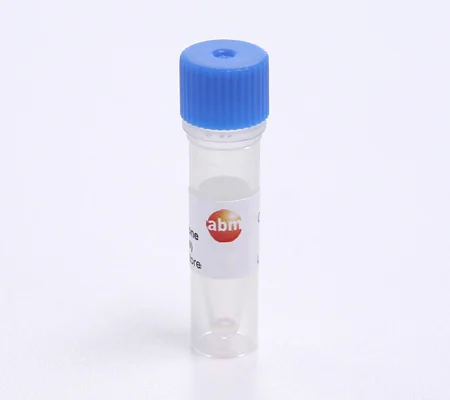
RNAifectin™ Transfection Reagent

| CAT.NO | UNIT |
|---|---|
| G073 | 1.0 ml (100-500 transfections) |
| Description | Especially developed for the efficient transfection of eukaryotic cells with RNAi oligo's. This transfection reagent is perfect for any of your RNAi transfection needs. |
|---|---|
| SKU | G073 |
| Applications | RNAi knockdown experiments in a wide variety of cell lines (HeLa, HEK-293 etc). Highly specific and non-toxic transfection. |
| Transfection Reagents Type | RNA Molecule |
| Caution | This product is distributed for laboratory research only. Caution: Not for diagnostic use . |
| Unit quantity | 1.0 ml (100-500 transfections) |
| Storage Condition | Store at 4ºC. Do not freeze. |
Does freeze-thaw affect the performance of the transfection reagent?
Freeze-thaw does damage the transfection reagent slightly, at an approximate 5% loss. If possible, test the agent with a GFP control first.
In your protocol there is no mention of 24 well or 12 well plates. Is the transfection still efficient if performed in such plates. If yes, what would be the quantities required to ensure a successful transfection.
The transfection step is a harsh and toxic environment for cells to be exposed to, and it is common to see some cell death as a result. Therefore we would recommend carrying out this step in 6-well plates at a minimum to ensure a good efficiency.
- Kaur, T et al. "Short interfering RNA against STAT1 attenuates cisplatin-induced ototoxicity in the rat by suppressing inflammation" Cell Death Dis. 2:e180 (2011). DOI: 10.1038/cddis.2011.63. Application: Transfection.
- Jajoo, S et al. "Essential Role of NADPH Oxidase-Dependent Reactive Oxygen Species Generation in Regulating MicroRNA-21 Expression and Function in Prostate Cancer" Antioxid Redox Signal 19(16):1863-1876 (2013). DOI: 10.1089/ars.2012.4820. PubMed: 23682737. Application: Transfection.
- Zhu, S et al. "Ubc9 promotes breast cell invasion and metastasis in a sumoylation independent manner" Oncogene 29:1763-1772 (2010). DOI: 10.1038/onc.2009.459 . Application: Trabsfection.
- Vanagamudi, B et al. "t-DARPP regulates phosphatidylinositol-3-kinasedependent" Molecular Cancer 240 (9):1-11 (2010). DOI: 10.1186/1476-4598-9-240.. Application: Transfection.
- Zhu, S et al. "MicroRNA-21 targets tumor suppressor genes in invasion" Cell Res. 18:350-359 (2008). DOI: 10.1038/cr.2008.24. Application: Transfection.
- Okuda, H et al. "miR-7 Suppresses Brain Metastasis of Breast Cancer Stem-Like Cells By Modulating KLF4" Cancer Res 73 (4):1434-1444 (2013). DOI: 10.1158/0008-5472.CAN-12-2037. PubMed: 23384942. Application: Transfection.
- Sachdeva, M et al. "p53 represses c-Myc through induction of the tumor suppressor miR-145" Proc. Natl. Acad. Sci. U. S. A. 106(9):3207-3212 (2009). DOI: 10.1073/pnas.0808042106. PubMed: 19202062.
- Zhang, Z et al. "Negative regulation of lncRNA GAS5 by miR-21" Cell Death Differ 20(11):1558-68 (2013). DOI: 10.1038/cdd.2013.110. PubMed: 23933812.
- Sachdeva, M et al. "MicroRNA-101-mediated Akt activation and estrogen-independent growth" Oncogene 30(7):822-31 (2011). DOI: 10.1038/onc.2010.463. PubMed: 20956939.
- Huang, J et al. "Long non-coding RNA UCA1 promotes breast tumor growth by suppression of p27 (Kip1)" Cell Death Dis 5:e1008 (2014). DOI: 10.1038/cddis.2013.541. PubMed: 24457952.
- Sachdeva, M et al. "MicroRNA-145 suppresses cell invasion and metastasis by directly targeting mucin 1" Cancer Res 70(1):378-87 (2010). DOI: 10.1158/0008-5472.CAN-09-2021. PubMed: 19996288.
- Singh, R et al. "Exosome-mediated transfer of miR-10b promotes cell invasion in breast cancer" Molecular Cancer 13(1):256 (2014). DOI: 10.1186/1476-4598-13-256. PubMed: 25428807. Application: Transfection.
- Ho, T.T. et al. "Targeting non-coding RNAs with the CRISPR/Cas9 system in human cell lines" Nucleic Acids Research (NAR) : (2014). PubMed: 25414344.
- Xing, F et al. "miR-509 suppresses brain metastasis of breast cancer cells by modulating RhoC and TNF-α" Oncogene. 37:4890-4900 (2015). DOI: 10.1038/onc.2014.412. PubMed: 25659578.
- Chen, Z et al. "SATB1 Promotes Pancreatic Cancer Growth and Invasion Depending on MYC Activation" Dig Dis Sci. 11:3304-3317 (2015). DOI: 10.1007/s10620-015-3759-9. PubMed: 26108419.
- Yuan, M., Meng, X. W., Ma, J., Liu, H., Song, S. Y., Chen, Q. C., ... & Peng, K. "Dexmedetomidine protects H9c2 cardiomyocytes against oxygen-glucose deprivation/reoxygenation-induced intracellular calcium overload and apoptosis through regulating FKBP12" 6/RyR2 signaling. Drug Design Development and Therapy:13 (2019).


